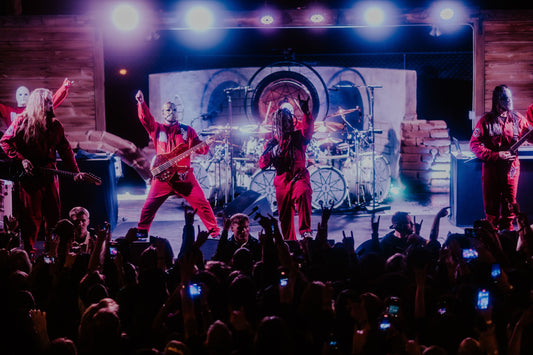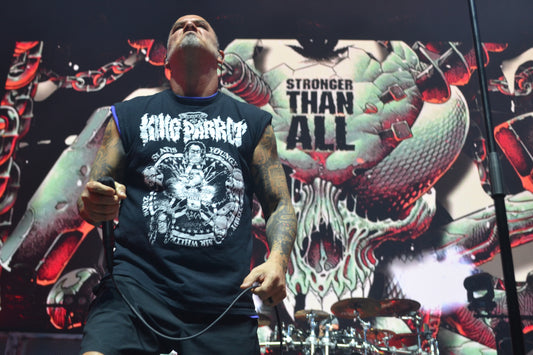For as much as music is regarded as more leisure aspect of life, we rarely examine how connected it is to our identity. There is an argument to be made that what you like and what you ARE like are much more linked than we care to acknowledge.
The often awkward, uncertain years of adolescence typically have an accompanying personal soundtrack and while that music will forever hold weight in terms of nostalgia, it also often clears a path of self - discovery.
For author John Wray, his most formative years included the exploration of music on the heavier end of the stylistic spectrum. Starting with the likes of Sabbath and Motörhead, Wray would venture further into the extreme, embracing the likes of Slayer, Carcass, Bathory, Sleep and Death.
Further building his own personal soundtrack, Wray also found camaraderie with like-minded friends, a sense of self-awareness through the art he grew passionate about and began a journey that would impact his professional path in the years to come. Ultimately, what Wray liked, became a contributing factorin what he was like.
Given the author's pedigree, on his sixth novel, Gone to the Wolves, it impossible to disregard the personal link - even if the account is a fictionalized one.
The story frames the friendship of three Floridian metalheads, all of which all find respite from their turbulent home life in their shared love for the heavy stuff. Kip is a Tallahassee transplant sent to live with his grandmother in Venice, FL. Kip eventually finds an existential revelation in the work of Chuck Schuldiner and the band Death.
Leslie thrives in his role of as an outlier multiple times over - a black, bisexual kid adopted by white parents. He further distances himself in being the rare Hanoi Rocks fan residing on Florida's Central Gulf Coast. Lastly, Kira serves as the fearless, free spirit of the trio, passionate to find what's real and of course, the love interest for Kip, naturally.
As the trio's friendship galvanizes over their shared love for metal, the backdrop shifts from the humidity and heft of Florida's death metal boom, to the glam, glitter and spandex-clad decadence of Southern California and the Sunset Strip.
In pursuit of their own personal passion, Kip finds his place as a journalist, dissecting the good, the bad and the ugly of L.A.'s ever-evolving rock music landscape. Kira takes on a gig at the famed Rainbow Room, witnessing first-hand the excess of the scene while Leslie becomes further immersed in the excess of the culture.
The progression of the characters' story accurately coincides with the progression of the sound. From the salad days of Florida's death metal boom, to the last pangs of hair metal's heyday, to the rise of the subversive black metal wave that captured international headlines, Gone to The Wolves offers an incredibly layered portrayal that is as nuanced as the art at its core - told with accuracy and authenticity.
The author spoke about the various subplots in his story and weighed in what it was like to take the conventional coming-of-age formula and implement metal as a defining component. He also shared how his personal love of the music influenced the stroke of his pen and compelled him to give the genre the flowers its long deserved.
There is an interesting contrast in the book in terms of location - Venice, FL. and Hollywood, CA. Given the regional identity of metal music, with Florida giving rise to important death metal and Hollywood nurturing glam - what was appealing about these two locations for this particular story?
Wray - Those were two very fun locations to write about. The decision to have a little group of metalheads at the center of my novel—Kip, Kira, and Leslie, best friends and metal true believers—meant that I could travel with them from one scene to another, and really show the variety of competing strains in metal in the late 80s and early 90's. Death, glam, Norwegian black—the kids in Gone to the Wolves want to experience it all.
Rightfully so, there is some Chuck Schuldiner worship woven into the story. Given that the band seems to be the connective tissue between all three of the main characters early on, how important was Death to you personally such that you made it the common denominator in this novel.
Wray - Death was crucial to me in my youth, from Scream Bloody Gore all the way through to the later, more prog-influenced albums that everybody disagrees about. Chuck was a difficult, driven person, and hard to be in a band with; but I've always felt a weird kind kinship with him. Maybe because we're both control freaks! He was so young when he started. An absolute virtuoso.
Metal is incredibly nuanced. For most people, the difference between glam metal and death metal just gets filed under the same "heavy" metal category. Was that something you considered when putting together this story? Was there any concern the audience would fall behind that language specific learning curve?
Wray - From the very beginning I knew that I wanted this book to be a celebration of metal music and culture. I also knew that some of my readers might know next to nothing about metal, so I felt a real responsibility to get it right. I promised myself that I wouldn't dumb things down or over-simplify. It was a balancing act, and tricky at times—that's for sure. Because I wanted to reach people who were prejudiced against this music, too, and make them think about it in a different way.
The kind of distain the Kip ultimately develops for the cliché and the pay-to-play scene of the Sunset Strip seems 1. All too familiar for the jaded journalist and 2. Feels strangely personal.
How much of Kip, if any, is actually you?
Wray - (Laughs) Well, we do share a birthday. And I worked as a music journalist too, just long enough to get fed up with a lot of the things that Kip comes to hate about the music business. But Kip is the real deal: from the first review he ever writes—about a band he can't stand!—he somehow knows he's found his destiny. I never went as deep as Kip did. I got out just in time.
It is a stretch to correlate the "White Room" Kip experiences - that primal, visceral rage and his emotional retreat - to the kind of release we experience in a circle pit? Falling into a fit of rage like the "White Room" seems to tap into that same emotional experience, don’t you think?
Wray - There's no question that heavy music can be cathartic—there's nothing better for your brain, in my opinion. Sometimes I think that's why people often say that metal fans are so 'surprisingly' nice and well-adjusted: I've never been surprised by that, because so much of our rage and frustration gets worked out through the music. God knows how Kip would have dealt with his suppressed rage without metal. He'd probably have ended up living in the White Room permanently.
The LA Times review ran with the idea that the story conveys a sense of loving something so much, in this case metal music, that it nearly kills you. Was this more intended to be a coming of age story with a metal subtext or was this supposed to be more about heavy music from a broader, cultural context?
Wray - No matter what point you might be trying to make in a novel, you've got to ground your ideas in things that the reader can actually see, hear, and touch. So even though I had a definite point of view that I wanted to get across, I had to begin with my characters—their struggles, their fears, the things they care about. One of those things, of course, is music; but Kip and Kira and Leslie also have families, and friends, and crushes, and all sorts of wild dreams about the future. We have to care about them as people if we're ever going to care about their world. When they do crazy things—and they do—the reader has to hope that they won't die. We're rooting for them, and we're happy for them when things go right.
There also does seem to be a little shade thrown at the cheese of 80’s glam - especially when positioned in contrast with the more extreme, heavier stuff that came out during the same era. Safe to say you fancy yourself more of a death metal guy than a glam rock guy?
Wray - Guilty as charged! I was a thrash kid, basically. One of the biggest challenges for me with Gone to the Wolves was to put myself in the shoes of Sunset Strip characters in the 80s who actually believe Faster Pussycat is the greatest band on earth. But I got to have some fun with it, too. The chapter where Kip and Kira find Vince Neill passed out in the bathroom of the Rainbow might be my favorite scene in the book. And our L.A. book party is actually at that very same bar, which is amazing.
Your recent Esquire article, ‘How Heavy Metal Saved My Life’ was a very poignant, personal piece that painted a very vivid picture of life in Buffalo. As you told the story of your bandmates, Gomper and J.T. and the kind of trauma they were navigating, even during your time in Asphalt Halo.
Do you subscribe to the idea that people with added emotional weight tend to gravitate towards heavy music? Do you the connection more about retreat or reaffirmation?
Wray - I can only really speak for myself and my friends—but in our case, we definitely did. There's a scene, early on in Gone to the Wolves, where Kip hears death metal for the very first time: a Death song, 'Denial of Life,' on his new friend Leslie's stereo. His reaction to the music could just as well have been written about me at the same age:
Horror films were Kip’s only point of reference, and not just because of the airbrushed zombie on the record's sleeve. He was being offered the same purifying fear, the same catharsis, the same revelation midnight slasher movies gave: that everything wasn’t going to be all right. Not now and not ever. And that made perfect sense to him.
Gone to the Wolves by John Wray is currently available - HERE





